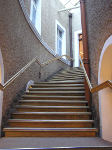Staircase Safety Tips for Seniors
Published by Stephen on November 9, 2010 Under fall prevention For the elderly and those who have difficulty getting around, it is not uncommon for the staircase to prevent a large hurdle in the home, which is difficult to use and presents a number of dangers for the senior. Among the types of incidents that cause hospitalization in seniors, staircase falls are one of the most common. However, in many cases, these falls can be prevented by proper staircase usage and maintenance.
For the elderly and those who have difficulty getting around, it is not uncommon for the staircase to prevent a large hurdle in the home, which is difficult to use and presents a number of dangers for the senior. Among the types of incidents that cause hospitalization in seniors, staircase falls are one of the most common. However, in many cases, these falls can be prevented by proper staircase usage and maintenance.
One of the most important factors when trying to reduce the risk of a staircase fall is the ability of the senior to use the stairs. In some-cases, often as the result of a combination of disorders like glaucoma, osteoporosis, or senior rheumatism, the senior can simply not safely use the staircase on their own anymore. It is no coincidence that so many fall related injuries occur on the stairs and determining if the senior will be safely able to use the stairs should always be the first step when increasing stairway safety.
Don’t Just Meet the Building Code, Exceed It!
However, it is also very important to consider the general condition and safety of the stairs, taking note of not only whether the staircase is in good repair or not, but also whether it exceeds safety standards. For instance, most building codes require that there is at least one handrail on the staircase, but studies have found that having a handrail on either side of the stairs dramatically reduces the risk of a stairway fall. In this way, exceeding the building code can often significantly reduce the risk of a fall.
While considering what type of handrail to use on the stairs or whether the current handrail is safe, it is important to keep in mind that the banister must be easy to grab by the senior in the event of an emergency or to keep their balance as they walk up the stairs. To that end, a banister that is too big to easily wrap ones hand around or that is made out of rough material that is painful to grab, can actually increase the risk of a fall, despite still passing inspection.
Let There Be Light!
Making sure that the senior can easily see the steps and the surrounding area is also very important, so having adequate lighting is essential to preventing staircase falls.
In addition to simply having a bright and clean burning light, it is also very important that the light can be easily used by the senior. So, there should be a light-switch on both the top landing and bottom landing of the staircase. In this manner, the senior will never be in a position where they must climb the stairs in the dark to reach the light-switch.
Of course, it is also a good idea to provide some sort of emergency lighting, so in the event of a power outage, the stairs will still be lit. Night lights can work, with some models automatically running on battery power when the lights go out, including the kind that double as a flashlight. However, make sure that the night-light provides enough light to use the stairs safely.
Make the Stairs Safer and Easier to Use
Along the same lines as meeting building codes, it is also important that you maintain these codes and keep the staircase in good repair. A loose board or piece of molding can create a huge tripping hazard, so making sure regular maintenance is preformed is essential.
It is also important to remove tripping hazards from the stairs, such as a purse on one of the steps or a child’s toy. However, other factors like a loose rug on the top landing, can also present a tripping risk. In the case of the loose carpet, it is possible the carpet may slide out from under the feet of the senior or the corner may turn up, increasing the risk of a fall. The same is true of carpet runners, which are not fully secured to the stairs.
Don’t Just Leave it Like it Was, Add to the Stairs
While some of the above tips focus more on working with the existing structure of the stairs, there are some things you can add to the staircase to make it safer.
Perhaps the least expensive option is to add grip-tape to the treads of the steps. This can server several purposes, by making the steps easier to feel for the senior, as well as increasing their traction, which reduces the risk of a fall. If you use brightly colored tape, you can add another level of protection, by making it easier for the senior to tell when one step starts and the other ends. It is a good idea to use separate colors for the top and bottom step, so they can always tell when the staircase ends.
Using a stair lift is another way to make the stairs safer. A stair lift is used to carry the senior up or down the steps, using a plastic chair or small platform. The style varies, but most use a tracked system that runs the entire length of the staircase, moving the senior smoothly along the track. The stair lift, or stair chair, does most of the work, with the senior only needing to get into and out of the chair, with the chair pivoting away from the stairs when transferring into or out of it.
No Comments |
Add a Comment